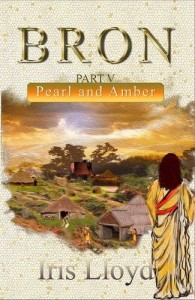Living Archaeology & Historical Fiction
by Iris Lloyd
On my desk sits a burnt flint I use as a paperweight. It is one of 70 tons found on an archaeological dig on top of the Berkshire Downs, south of the Ridgeway, a site that was occupied for over 1,000 years. I used to live half a mile away and helped with the digging. Intrigued, I was inspired to write a series of novels about Bron, born there in AD 385, at the end of the Roman occupation. With such personal knowledge, I worked several of our finds into the stories including a Medusa medallion, a dog skeleton and a rare fish brooch, indicating Christian activity. A silver ring was also found there, in the shape of hands holding a heart surmounted by a crown. This is now known as an Irish claddagh ring, but it is much older in origin.
A few other authors have also drawn inspiration from the actual experience of participating in a dig. One is Margaret Elphinstone, whose latest novel, The Gathering Night (Canongate, 2009), was prompted by a flint shard, a microlith, found during a dig at a Mesolithic site on the Hebridean island of Coll. As well as taking part in this dig, Elphinstone’s research included building a coracle. My research included forging a log poker at a blacksmith’s.
Googling “Novels based on archaeology” brings up dozens of books, including classics by Jean M. Auel (The Clan of the Cave Bear, 1980), Richard Harris (Pompeii, 2003), several by Lindsey Davis, and so on. For the most part, they are written about places already explored. Edward Rutherfurd in London (1997) created a Roman Arch on the site of Marble Arch, where he felt one must have existed, though he didn’t get down on hands and knees with a scraper to look for the foundations! The reasons are obvious: serious archaeologists deal in fact and not make-believe, whereas historical novelists base their stories on fact but need to let their imaginations fly.
I was scraping the side of a pit one day when I saw what I thought was a pin from the back of a brooch and called the archaeologist over. “That’s not a fibula,” he said, “it’s a baby’s rib bone.” Sure enough, on further scraping, the baby’s skeleton was revealed. We found over 50 of them (premature, stillborn and new born) all over the site in pits, ditches and post holes. Babies were thought to be of no value until about five years old and may have been buried in this way during fertility rites or to bring luck. I have included the sacrifice of a baby girl in my narrative.
As to the burnt flints: found in abundance in the chalk, they were placed in the fire then dropped into water to heat it. During a coach ride south after an Alaskan cruise, the driver informed us that we were passing through land that belonged to the Stoney Indians. He said, “They were called Stoney Indians because they used to put stones into the fire then drop them into water to heat it.” Of course, I told him that we were using the same method in Britain thousands of years ago. I was telling this story to a visitor to my bookstall and she said, “My mother used to do that when the electricity was cut off during the war.”
Sadly, after 35 years of excavations, the site has now been closed. Current thinking in professional circles is that artefacts should be left in the ground for future generations to find. Just as we regard the Victorian diggers as vandals, taking away the interesting finds and discarding everything else, without recording any data, so future generations may regard us in the same way. However, all our discoveries are being recorded onto databases and the artefacts will eventually be donated to Newbury Museum. One unique Roman coin among about 1,000 found has gone to the British Museum to fill a gap in a collection.
I am so glad that I was around at the right time and that Bron in her pagan Atrebate settlement has been brought to life up there on the Berkshire Downs.
About the contributor: IRIS LLOYD is a writer who is passionate about archeology. The series of Bron novels is published by Pen Press publishers. For more information, see irislloyd.co.uk.
______________________________________________
Published in Historical Novels Review | Issue 66, November 2013







